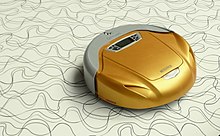
A mobile robot is an automatic machine that is capable of locomotion.[1] Mobile robotics is usually considered to be a subfield of robotics and information engineering.[2]
Mobile robots have the capability to move around in their environment and are not fixed to one physical location. Mobile robots can be "autonomous" (AMR - autonomous mobile robot) which means they are capable of navigating an uncontrolled environment without the need for physical or electro-mechanical guidance devices.[3] Alternatively, mobile robots can rely on guidance devices that allow them to travel a pre-defined navigation route in relatively controlled space.[4] By contrast, industrial robots are usually more-or-less stationary, consisting of a jointed arm (multi-linked manipulator) and gripper assembly (or end effector), attached to a fixed surface. The joint.
Mobile robots have become more commonplace in commercial and industrial settings. Hospitals have been using autonomous mobile robots to move materials for many years. Warehouses have installed mobile robotic systems to efficiently move materials from stocking shelves to order fulfillment zones. Mobile robots are also a major focus of current research and almost every major university has one or more labs that focus on mobile robot research.[5] Mobile robots are also found in industrial, military and security settings.
The components of a mobile robot are a controller, sensors, actuators and power system.[3] The controller is generally a microprocessor, embedded microcontroller or a personal computer (PC). The sensors used are dependent upon the requirements of the robot. The requirements could be dead reckoning, tactile and proximity sensing, triangulation ranging, collision avoidance, position location and other specific applications.[6] Actuators usually refer to the motors that move the robot can be wheeled or legged. To power a mobile robot usually we use DC power supply (which is battery) instead of AC.
- ^ Hu, J.; Bhowmick, P.; Lanzon, A., "Group Coordinated Control of Networked Mobile Robots with Applications to Object Transportation" IEEE Transactions on Vehicular Technology, 2021.
- ^ "Information Engineering Main/Home Page". www.robots.ox.ac.uk. Retrieved 2018-10-03.
- ^ a b Hu, J.; Bhowmick, P.; Jang, I.; Arvin, F.; Lanzon, A., "A Decentralized Cluster Formation Containment Framework for Multirobot Systems" IEEE Transactions on Robotics, 2021.
- ^ Hu, J.; Turgut, A.; Lennox, B.; Arvin, F., "Robust Formation Coordination of Robot Swarms with Nonlinear Dynamics and Unknown Disturbances: Design and Experiments" IEEE Transactions on Circuits and Systems II: Express Briefs, 2021.
- ^ P. Moubarak, P. Ben-Tzvi, Adaptive Manipulation of a Hybrid Mechanism Mobile Robot, IEEE International Symposium on Robotic and Sensors Environments (ROSE), Montreal, Canada, 2011, pp. 113 - 118
- ^ Gopalakrishnan, B.; Tirunellayi, S.; Todkar, R. (2014). "Design and development of an autonomous mobile smart vehicle: a mechatronics application". Mechatronics. 14 (5): 491–514. doi:10.1016/j.mechatronics.2003.10.003.